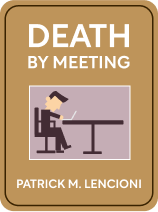

This article is an excerpt from the Shortform book guide to "Death By Meeting" by Patrick M. Lencioni. Shortform has the world's best summaries and analyses of books you should be reading.
Like this article? Sign up for a free trial here .
What are the four different types of meetings in a company? How should each type of meeting be run?
In the business fable Death by Meeting, Patrick Lencioni describes the four types of meetings in a company. The types of meetings are: the check-in, the tactical, the strategic, and the review. He explains how each one should be run and how long they should be.
Continue on to learn about the four types of meetings in a company.
The Four Types of Meetings in a Company
Carefully tailor each of these types of meetings, just like each of the mediums they are based on. Employees should know what they’re signing up for—whether it be a five-minute news broadcast or a whole miniseries. Let’s break down the four types of business meetings:
1. The Check-in
This type of meeting happens daily. People are constantly asking who’s in the office, or what their schedules look like. These questions could all be answered at the beginning of each day at the check-in meeting. Keep these short—5 minutes or less—so people don’t get burned out by the check-in.
2. The Tactical
This meeting happens weekly and lasts an hour or less. Begin with everyone there giving a summary of their projects in a minute or less. After that, rather than before, the team will figure out the agenda. This way, the team can decide on what to talk about after they know what’s going on. They’ll discuss together what topics are the most important to focus on. After the team chooses the topics, they make sure to limit the conversation to actionables directly relevant to the agreed-upon agenda.
3. The Strategic
This meeting is monthly and lasts between two and four hours. If there are conversation topics that are important but not directly related to the agenda that come up in the tactical meeting, like discussing a competitor, they’ll table them until the strategic meeting. This is so that people aren’t constantly shifting off of the agenda and then trying to come back to it. It helps keep two types of discussions—day-to-day and larger strategic—separate from one another. If a strategic discussion has to happen, still don’t do it in the tactical meeting. Call an ad hoc strategic meeting for that evening. Another important piece of the strategic meeting is that the agenda remains small. There should only be one to two strategic discussions on the agenda. That way, the strategic discussions can be in-depth. These meetings need an agenda, which will usually come from the most salient topics raised at the weekly tactical meetings. This is also the meeting where you’ll be exploring and encouraging conflict.
4. The Review
Conduct this meeting every quarter and hold it off-site. Budget a full day, or even a weekend, for these meetings. This, above all else, is a time for review. Some potential questions could be: How is the morale of the team? What up-and-coming companies are challengers? Who are the best and worst performers? What do the customers think of the product? At these meetings, it can be useful to bring in an outside consultant to review and facilitate discussion.
Tips for All Types of Meetings
- The problems with the meetings included:
- Starting late
- Being unfocused
- Prioritizing the wrong topics
- Missing key players
- Meetings get better when participants inject drama into them.
- If a company has issues with meetings, it’s not necessarily that they have too many. In fact, it’s likely that they have too few.
- There are four types of meetings that every successful business should employ.

———End of Preview———
Like what you just read? Read the rest of the world's best book summary and analysis of Patrick M. Lencioni's "Death By Meeting" at Shortform .
Here's what you'll find in our full Death By Meeting summary :
- Why are meetings so important and detrimental at the same time
- The top 3 issues that commonly plague meetings
- Why a meeting where participants disagree can be a good thing






